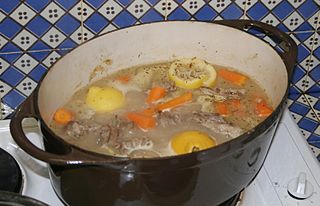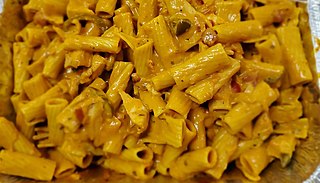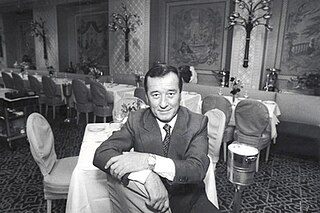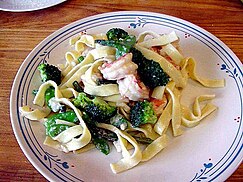
Gnocchi are a varied family of dumplings in Italian cuisine. They are made of small lumps of dough, such as those composed of a simple combination of wheat flour, potato, egg, and salt. Variations of the dish supplement the simple recipe with flavour additives, such as semolina flour, cheese, breadcrumbs, cornmeal or similar ingredients, and possibly including herbs, vegetables, and other ingredients. Base ingredients may be substituted with alternatives such as sweet potatoes for potatoes or rice flour for wheat flour. Such variations are often considered to be non-traditional.

Carbonara is a pasta dish made with fatty cured pork, hard cheese, eggs, salt, and black pepper. It is typical of the Lazio region of Italy. The dish took its modern form and name in the middle of the 20th century.

Fettuccine Alfredo is a pasta dish made with fettuccine, butter, and Parmesan cheese. As the cheese is mixed with freshly cooked, warm fettuccine and ample butter, it melts and emulsifies to form a smooth, rich cheese sauce coating the noodles. Originated in Rome in the early 20th century, it is now popular in the United States and other countries. Cream is commonly added to American versions, which are often served as a main course with optional chicken, shrimp, salmon or other ingredients on top or on the side.

Blanquette de veau is a French veal stew. In the classic version of the dish the meat is simmered in a white stock and served in a sauce velouté enriched with cream and egg. It is among the most popular meat dishes in France.

Penne alla vodka is a pasta dish made primarily with vodka and penne, usually accompanied with heavy cream, crushed tomatoes or tomato sauce, onions, and sometimes small meats and vegetables such as sausage, pancetta or peas. The alcohol is said to intensify and accentuate flavors in the dish.

Craig Claiborne was an American restaurant critic, food journalist and book author. A long-time food editor and restaurant critic for The New York Times, he was also the author of numerous cookbooks and an autobiography. Over the course of his career, he made many contributions to gastronomy and food writing in the United States.

Italian-American cuisine is a style of Italian cuisine adapted throughout the United States. Italian-American food has been shaped throughout history by various waves of immigrants and their descendants, called Italian Americans.

Gratin is a culinary technique in which an ingredient is topped with a browned crust, often using breadcrumbs, grated cheese, egg or butter. The term may be applied to any dish made using this method. Gratin is usually prepared in a shallow dish of some kind. A gratin is baked or cooked under an overhead grill or broiler to form a golden crust on top and is often served in its baking dish.

Spaghetti and meatballs is an Italian-American pasta dish consisting of spaghetti, tomato sauce, and meatballs.

Pierre Franey was a French-born American chef, best known for his televised cooking shows and his "60 Minute Gourmet" column in The New York Times.

Steak Diane is a dish of pan-fried beefsteak with a sauce made from the seasoned pan juices. It was originally cooked tableside and sometimes flambéed. It was most likely invented in London in the 1930s. From the 1940s through the 1960s it was a standard dish in "Continental cuisine", and is now considered retro.

Le Cirque was a French restaurant that has had several locations throughout the New York City borough of Manhattan for more than forty years. It is currently closed, with its future status unknown.

Chicken riggies or Utica riggies is an Italian-American pasta dish native to the Utica–Rome area of New York State. Although many variations exist, it is a pasta-based dish typically consisting of chicken, rigatoni, and hot or sweet peppers in a spicy cream and tomato sauce. Many of the chefs from the Utica area seem to have a claim to the dish, yet there seems to be no clear idea who was the originator.

Sirio Maccioni was an Italian restaurateur and author known for opening Le Cirque.
Roberts Island is a community located in the Yarmouth Municipal District of Yarmouth County in Nova Scotia, Canada.

Spaghetti alle vongole is a pasta dish consisting of spaghetti cooked with fresh clams. It is a traditional dish originating from the coastal regions of Southern Italy, particularly Naples and the Campania region. The preparation typically involves garlic, parsley, olive oil, and occasionally white wine. Palourde, or carpet-shell clams, are commonly used, along with the small Mediterranean wedge shell. There are numerous regional variations of the dish.

Crème brûlée or crème brulée, also known as burnt cream or Trinity cream, and virtually identical to crema catalana, is a dessert consisting of a rich custard base topped with a layer of hardened caramelized sugar. It is normally served slightly chilled; the heat from the caramelizing process tends to warm the top of the custard, while leaving the center cool. The custard base is generally flavored with vanilla in French cuisine, but can have other flavorings. It is sometimes garnished with fruit.

Carlo Camillo Amato Chiaramonte Bordonaro, more commonly known as Baron Carlo Amato, was an Italian-born aristocrat and businessman who lived in both Canada and the United States.

Florentine or à la Florentine is a term from classic French cuisine that refers to dishes that typically include a base of cooked spinach, a protein component and Mornay sauce. Chicken Florentine is the most popular version. Because Mornay sauce is a derivation of béchamel sauce which includes roux and requires time and skill to prepare correctly, many contemporary recipes use simpler cream-based sauces.



















